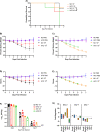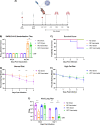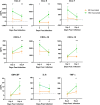Diet-induced obesity and diabetes enhance mortality and reduce vaccine efficacy for SARS-CoV-2
- PMID: 37846985
- PMCID: PMC10688338
- DOI: 10.1128/jvi.01336-23
Diet-induced obesity and diabetes enhance mortality and reduce vaccine efficacy for SARS-CoV-2
Abstract
Severe acute respiratory syndrome coronavirus-2 (SARS-CoV-2) has caused a wide spectrum of diseases in the human population, from asymptomatic infections to death. It is important to study the host differences that may alter the pathogenesis of this virus. One clinical finding in coronavirus disease 2019 (COVID-19) patients is that people with obesity or diabetes are at increased risk of severe illness from SARS-CoV-2 infection. We used a high-fat diet model in mice to study the effects of obesity and type 2 diabetes on SARS-CoV-2 infection as well as how these comorbidities alter the response to vaccination. We find that diabetic/obese mice have increased disease after SARS-CoV-2 infection and they have slower clearance of the virus. We find that the lungs of these mice have increased neutrophils and that removing these neutrophils protects diabetic/obese mice from disease. This demonstrates why these diseases have increased risk of severe disease and suggests specific interventions upon infection.
Keywords: coronavirus; diabetes; immunization.
Conflict of interest statement
M.B.F. is on the scientific advisory board of Aikido Pharma and has collaborative research agreements with Novavax, AstraZeneca, Regeneron, and Irazu Bio. These do not have any effect on the planning or interpretations of the work presented in this manuscript. N.P. and G.S are employees of Novavax.
Figures








Update of
-
Diet Induced Obesity and Diabetes Enhance Mortality and Reduces Vaccine Efficacy for SARS-CoV-2.bioRxiv [Preprint]. 2023 May 5:2022.10.15.512291. doi: 10.1101/2022.10.15.512291. bioRxiv. 2023. Update in: J Virol. 2023 Nov 30;97(11):e0133623. doi: 10.1128/jvi.01336-23. PMID: 36299426 Free PMC article. Updated. Preprint.
Similar articles
-
Reduced SARS-CoV-2 mRNA vaccine immunogenicity and protection in mice with diet-induced obesity and insulin resistance.J Allergy Clin Immunol. 2023 Nov;152(5):1107-1120.e6. doi: 10.1016/j.jaci.2023.06.031. Epub 2023 Aug 16. J Allergy Clin Immunol. 2023. PMID: 37595760 Free PMC article.
-
COVID-19 mRNA vaccine protects against SARS-CoV-2 Omicron BA.1 infection in diet-induced obese mice through boosting host innate antiviral responses.EBioMedicine. 2023 Mar;89:104485. doi: 10.1016/j.ebiom.2023.104485. Epub 2023 Feb 27. EBioMedicine. 2023. PMID: 36857860 Free PMC article.
-
Exploring the associations between gut microbiota composition and SARS-CoV-2 inactivated vaccine response in mice with type 2 diabetes mellitus.mSphere. 2024 Sep 25;9(9):e0038024. doi: 10.1128/msphere.00380-24. Epub 2024 Aug 27. mSphere. 2024. PMID: 39189780 Free PMC article.
-
Insights into COVID-19 Vaccine Development Based on Immunogenic Structural Proteins of SARS-CoV-2, Host Immune Responses, and Herd Immunity.Cells. 2021 Oct 29;10(11):2949. doi: 10.3390/cells10112949. Cells. 2021. PMID: 34831172 Free PMC article. Review.
-
Human and novel coronavirus infections in children: a review.Paediatr Int Child Health. 2021 Feb;41(1):36-55. doi: 10.1080/20469047.2020.1781356. Epub 2020 Jun 25. Paediatr Int Child Health. 2021. PMID: 32584199 Review.
Cited by
-
The emerging role of the gut microbiota in vaccination responses.Gut Microbes. 2025 Dec;17(1):2549585. doi: 10.1080/19490976.2025.2549585. Epub 2025 Aug 30. Gut Microbes. 2025. PMID: 40884514 Free PMC article. Review.
-
FABP4 as a therapeutic host target controlling SARS-CoV-2 infection.EMBO Mol Med. 2025 Mar;17(3):414-440. doi: 10.1038/s44321-024-00188-x. Epub 2025 Jan 22. EMBO Mol Med. 2025. PMID: 39843629 Free PMC article.
-
Assessment of COVID-19 Vaccine Effectiveness Against SARS-CoV-2 Infection, Hospitalization and Death in Mexican Patients with Metabolic Syndrome from Northeast Mexico: A Multicenter Study.Vaccines (Basel). 2025 Feb 27;13(3):244. doi: 10.3390/vaccines13030244. Vaccines (Basel). 2025. PMID: 40266114 Free PMC article.
-
Effectiveness of SARS-CoV-2 primary vaccines and boosters in patients with type 2 diabetes mellitus in Hungary (HUN-VE 4 Study).BMJ Open Diabetes Res Care. 2024 Jan 24;12(1):e003777. doi: 10.1136/bmjdrc-2023-003777. BMJ Open Diabetes Res Care. 2024. PMID: 38267204 Free PMC article.
-
Impaired inflammatory resolution with severe SARS-CoV-2 infection in leptin knock out obese hamster.iScience. 2025 Jan 17;28(2):111837. doi: 10.1016/j.isci.2025.111837. eCollection 2025 Feb 21. iScience. 2025. PMID: 39981511 Free PMC article.
References
-
- CDC . n.d. National diabetes statistics report. Available from: https://www.cdc.gov/diabetes/data/statistics-report/index.html
-
- Kompaniyets L, Goodman AB, Belay B, Freedman DS, Sucosky MS, Lange SJ, Gundlapalli AV, Boehmer TK, Blanck HM. 2021. Body mass index and risk for COVID-19-related hospitalization, intensive care unit admission, invasive mechanical ventilation, and death - United States, March-December 2020. MMWR Morb Mortal Wkly Rep 70:355–361. doi:10.15585/mmwr.mm7010e4 - DOI - PMC - PubMed
Publication types
MeSH terms
Substances
Grants and funding
LinkOut - more resources
Full Text Sources
Medical
Miscellaneous

